
John Stith Pemberton was an American pharmacist and Confederate States Army veteran who is best known as the inventor of Coca-Cola. In May 1886, he developed an early version of a beverage that would later become Coca-Cola, but sold its rights to the drink shortly before his death in 1888.
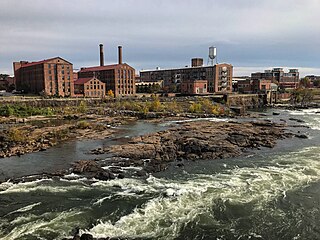
Columbus is a consolidated city-county located on the west-central border of the U.S. state of Georgia. Columbus lies on the Chattahoochee River directly across from Phenix City, Alabama. It is the county seat of Muscogee County, with which it officially merged in 1970; the original merger excluded Bibb City, which joined in 2000 after dissolving its own city charter.

George Foster Peabody was an American banker and philanthropist.
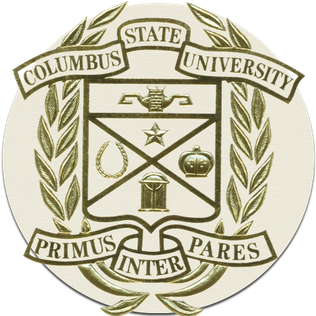
Columbus State University is a public university in Columbus, Georgia. Founded as Columbus College in 1958, the university was established and is administered by the Board of Regents of the University System of Georgia.

Jonathan Norcross was elected in 1850 as the fourth Mayor of Atlanta, Georgia, serving the customary term at the time of one year. Dubbed the "Father of Atlanta" and "hard fighter of everything" by publisher Henry W. Grady, he followed three mayors elected from the Free and Rowdy Party.

John Work Garrett was an American merchant turned banker who became president of the Baltimore and Ohio Railroad (B&O) in 1858 and led the railroad for nearly three decades. The B&O became one of the most important American railroads by the time Garrett died, and Garret would also become a noted philanthropist. He provided crucial support for the Union cause during the Civil War, expanded the railroad to reach Chicago, Illinois, and competed with the Pennsylvania Railroad for access to New York City.

Eli Lilly was an American soldier, pharmacist, chemist, and businessman who founded the Eli Lilly and Company pharmaceutical corporation. Lilly enlisted in the Union Army during the American Civil War and recruited a company of men to serve with him in the 18th Independent Battery Indiana Light Artillery. He was later promoted to major and then colonel, and was given command of the 9th Regiment Indiana Cavalry. Lilly was captured in September 1864 and held as a prisoner of war until January 1865. After the war, he attempted to run a plantation in Mississippi, but it failed and he returned to his pharmacy profession after the death of his first wife.

Southern Family Markets, headquartered in Birmingham, Alabama, was a chain of American supermarkets owned and operated by C&S Wholesale Grocers, a distributor based in Keene, New Hampshire. The chain was operated as an affiliate of C&S. Southern Family Markets had operated a varying number of supermarkets and 10 liquor stores under the banners Southern Family Markets, Piggly Wiggly, Bruno's, and Food World. The liquor stores, all located along the gulf coast, were called SFM Liquors.

Henry Winslow Corbett was an American businessman, politician, civic benefactor, and philanthropist in the state of Oregon. A native of Massachusetts, he spent his early life in the East and New York before moving to the Oregon Territory. He was a prominent figure in the early development of Portland, Oregon, and was involved in numerous business ventures there, starting in general merchandise. His interests later included banking, finance, insurance, river shipping, stage lines, railways, telegraph, iron and steel and the erection of Portland downtown buildings among other enterprises. A Republican, he served as a United States senator from 1867 to 1873.

Borden, Inc., was an American producer of food and beverage products, consumer products, and industrial products. At one time, the company was the largest U.S. producer of dairy and pasta products. Its food division, Borden Foods, was based in Columbus, Ohio, and focused primarily on pasta and pasta sauces, bakery products, snacks, processed cheese, jams and jellies, and ice cream. It was best known for its Borden Ice Cream, Meadow Gold milk, Creamette pasta, and Borden Condensed Milk brands. Its consumer products and industrial segment marketed wallpaper, adhesives, plastics and resins. By 1993, sales of food products accounted for 67 percent of its revenue. It was also known for its Elmer's and Krazy Glue brands.
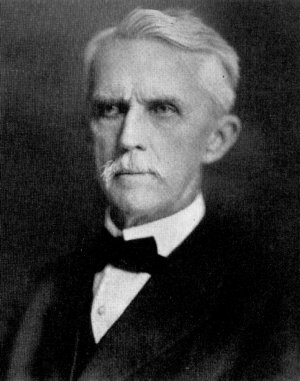
Philip Keyes Yonge, usually given as P. K. Yonge, was a businessman and civic leader. A resident of Pensacola, he was a prominent Floridian. A founding member of the Florida Board of Control, he served on that board for almost 30 years as a member and chairman. The P.K. Yonge Developmental Research School in Gainesville is named for him.
The W. C. Bradley company is an American manufacturer of consumer goods. It comprises four companies based on home and leisure products and services: Char-Broil, Lamplight, and W. C. Bradley Co. Real Estate.

Horace King was an African-American architect, engineer, and bridge builder. King is considered the most respected bridge builder of the 19th century Deep South, constructing dozens of bridges in Alabama, Georgia, and Mississippi. King was born into slavery on a South Carolina plantation in 1807. A slave trader sold him to a man who saw something special in Horace King. His owner, John Godwin, taught King to read and write as well as how to build at a time when it was illegal to teach slaves. King worked hard and despite bondage, racial prejudice and a multitude of obstacles, King focused his life on working hard and being a genuinely good man. King built bridges, warehouses, homes, and churches. Horace King became a highly accomplished Master Builder and he emerged from the Civil War as a legislator in the State of Alabama. Affectionately known as Horace “The Bridge Builder” King and the "Prince of Bridge Builders," he also served his community in many important civic capacities."
The Garrett-Bullock House is a historic Queen Anne-style house in Columbus, Georgia. It was listed on the National Register of Historic Places in 1980.
Grapico is a caffeine-free, artificially flavored carbonated soft drink with a purple color and a grape taste that is sold in the Southeastern United States. When introduced in 1916, the product quickly became a success, which in part was due to implying that Grapico contained real grape juice even though it contained fake juice. In the spring of 1926, J. Grossman's Sons sold the Grapico business to the Pan American Manufacturing Company in New Orleans. Pan American continued J. Grossman's Sons' improper practice of implying that Grapico contained real grape juice and lost the right to use the word "Grapico" to designate their artificial grape drink in 1929.

The Piedmont Hotel was a hotel in Downtown Atlanta, Georgia, United States. Construction on the building, which was designed by architect Willis F. Denny, began in 1901, and the building was opened to the public in January 1903. Considered one of the finest hotels in the city at the time, numerous famous guests stayed at the hotel while visiting Atlanta, including three presidents of the United States. Unlike other Atlanta hotels, the Piedmont sought to emulate the style of hotels in the northeastern United States and was commonly referred to by locals as "our New York City hotel". In 1929, the building went through an extensive renovation overseen by the architectural firm of Pringle & Smith. In 1965, the owners of the hotel agreed to sell the property to the Equitable Life Assurance Society of the United States, who planned to build a new office building on the site. The hotel was demolished that year and in 1968, the Equitable Building was completed.
Washington Hall was a historic hotel in antebellum Atlanta, Georgia. Built in 1846, the building was one of the earliest hotels built in the city. The hotel, along with many other structures in the city, was destroyed in 1864 during the Battle of Atlanta.
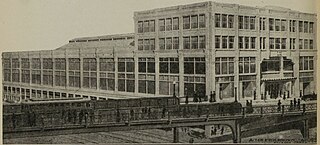
The Peachtree Arcade was a shopping arcade in downtown Atlanta, Georgia, United States. The building, modeled after the Arcade in Cleveland, was designed by Atlanta-based architect A. Ten Eyck Brown and was located between Peachtree Street and Broad Street near Five Points. Construction began in 1917 and was completed the following year. Located in the city's central business district, it was very popular with citizens, functioning as an unofficial "civic center" for the city. However, by the 1960s, the arcade was facing increased competition from shopping malls located in Atlanta's suburbs, and in 1964, the building was demolished to make way for the First National Bank Building, a skyscraper that, at the time of its construction, was the tallest building in both Atlanta and the southeastern United States. In 1993, the American Institute of Architects named the building as one of Atlanta's most notable landmarks to have been destroyed.
Milo-Grogan is a neighborhood of Columbus, Ohio. The neighborhood was settled as the separate communities of Milo and Grogan in the late 1870s. Large-scale industrial development fueled the neighborhood's growth until the 1980s, when the last factories closed. The community has received urban renewal efforts in recent years fueled by the Columbus Department of Development and Milo-Grogan Area Commission.
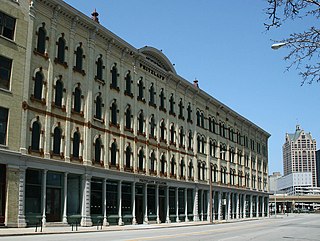
The John Pritzlaff Hardware Company is a complex of Italianate-styled buildings built from 1875 to 1919, a remnant of what was for years the largest wholesale hardware business in Milwaukee and the region. In 2013 the buildings were listed on the National Register of Historic Places.














